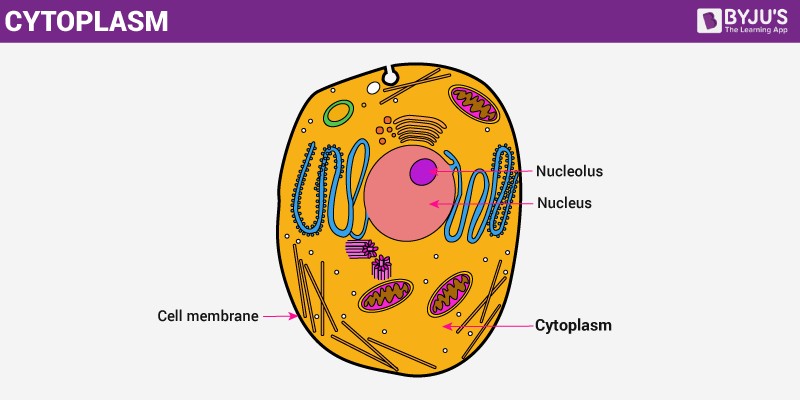The cytoplasm is a fundamental component of living cells, playing a vital role in cellular processes. Coined in 1863 by Swiss biologist Rudolf von Kölliker, the term initially served as a synonym for protoplasm. Over time, its definition evolved to represent the cell’s contents excluding the nucleus. Understanding the cytoplasm is crucial for comprehending cell biology.
Delving into the Cytoplasm: Definition and Composition
The cytoplasm is the gel-like substance filling the cell. It’s a complex mixture comprising the cytosol, various filaments, ions, proteins, and macromolecular structures. All organelles within the cell are suspended in the cytoplasm.
 CytoplasmThe cytoplasm, a fluid matrix, supports cellular organelles and facilitates various intracellular processes within the cell’s confines.
CytoplasmThe cytoplasm, a fluid matrix, supports cellular organelles and facilitates various intracellular processes within the cell’s confines.
While traditionally viewed as a fluid, emerging research suggests the cytoplasm possesses properties akin to glass-forming liquids, challenging previous assumptions about its consistency.
In eukaryotic cells, the cytoplasm encompasses everything within the cell membrane except the nucleus. Conversely, prokaryotic cells, lacking a defined nucleus, have their genetic material present within the cytoplasm. Prokaryotic cytoplasm is simpler in structure compared to that of eukaryotes, reflecting the overall simpler organization of these cells.
Structure of the Cytoplasm: A Closer Look
Cells consist of three primary elements: the plasma membrane, the nucleus, and the cytoplasm.
The plasma membrane, or cell membrane, is a double-layered structure composed of lipids that separates the cell’s internal components from the external environment and surrounding cells. It acts as a barrier, enclosing the cytoplasm, nucleus, and other organelles.
The nucleus, the largest organelle, holds exclusive control over cellular activities.
The cytoplasm, a jelly-like substance, fills the space between the nucleus and the cell membrane, embedding the various cell organelles. These organelles, including the endoplasmic reticulum, mitochondria, ribosomes, and vacuoles, are suspended within the cytoplasm, each performing specific functions essential for cell survival.
The cytoplasm’s structure can be visualized under a microscope using staining techniques, allowing for detailed examination of its components. Functionally, it serves as the site for numerous chemical reactions, with most of the cell’s metabolism taking place within its boundaries.
Cytoplasm Function: Supporting Life Processes
The cytoplasm plays diverse roles in maintaining cell health and functionality. One key function is maintaining cell turgidity, enabling cells to retain their shape. Additional functions include:
- Support and Suspension: The cytoplasm’s jelly-like consistency, a mix of salt and water, suspends and supports cellular organelles within the cell membrane.
- Waste Breakdown: The cytoplasm hosts molecules and enzymes vital for breaking down cellular waste products.
- Metabolic Activities: Metabolic processes rely on the cytoplasm for crucial support and resources.
- Cell Shape Maintenance: By filling the cell, the cytoplasm ensures organelles remain in their correct positions, preventing cellular deflation and facilitating efficient substance transfer.
- Cytosol Function: The cytosol, a component of the cytoplasm, is a matrix filling the cell sections unoccupied by organelles.
Cytoplasm vs. Protoplasm: Understanding the Difference
The term “protoplasm” refers to the total cellular content of a living cell. It encompasses the cytoplasm, the nucleus, and all other living components within the cell. The cytoplasm, therefore, is a part of the protoplasm.
Protoplasm: The Essence of Life
Protoplasm is considered the living component of the cell, a colorless, jelly-like substance composed of macromolecules, water, and small molecules. It encompasses both inorganic and organic substances, including the cytoplasm, nucleus, mitochondria, and plastids. As the chief substance responsible for all life processes, it supports cell regulation, shape, and stores necessary chemicals for organelle function.
The Nucleus: The Control Center
The nucleus, a membrane-bound organelle primarily found in eukaryotic cells, is a crucial element. While most eukaryotes contain a single nucleus, certain cell types, such as red blood cells, lack one.
In Conclusion: The Importance of Cytoplasm
The cytoplasm is not simply a filler substance but an active environment crucial for cell survival and function. Its intricate structure and diverse roles make it a key area of study in cell biology, furthering our understanding of life’s fundamental building blocks. Understanding the cytoplasm and its function is key to understanding life.